LED Aviation Obstruction Light: Enhancing Safety in Airspace Navigation
Aviation safety relies heavily on effective obstruction lighting to prevent collisions between aircraft and tall structures. Among the most advanced solutions available today, LED aviation obstruction lights have revolutionized visibility, energy efficiency, and reliability in both day and nighttime operations. This article explores their significance, types, regulatory compliance, and technological advantages.
The Role of LED Aviation Obstruction Lights
Obstruction lights serve as critical visual markers for pilots, indicating the presence of tall structures such as towers, wind turbines, bridges, and skyscrapers. LED aviation obstruction lights are particularly effective due to their high luminosity, low power consumption, and long operational lifespan. They ensure that structures remain visible under various weather conditions, reducing the risk of mid-air collisions.
Types of LED Aviation Obstruction Lights
1. Low-Intensity Obstruction Lights (L-810)
Used for structures below 45 meters (148 feet), these lights provide steady red illumination. They are commonly installed on buildings, cranes, and telecommunication masts in urban areas.
2. Medium-Intensity Obstruction Lights (L-864 & L-865)
Designed for structures between 45 and 150 meters (492 feet), these lights can emit either steady red (L-864) or flashing white (L-865) signals. They are ideal for wind farms and high-rise constructions.

3. High-Intensity Obstruction Lights (L-856 & L-857)
Required for structures exceeding 150 meters, these powerful flashing white lights (L-856 for daytime, L-857 for nighttime) ensure maximum visibility from long distances. They are commonly used on broadcast towers and tall industrial chimneys.
4. Dual Lighting Systems (L-864/L-865 Combo)
Some installations combine medium-intensity red and white lights, automatically adjusting based on ambient light conditions. This dual-mode operation enhances safety while conserving energy.
Advantages of LED Technology in Obstruction Lighting
1. Energy Efficiency
LEDs consume significantly less power than traditional incandescent or halogen lights, reducing operational costs and environmental impact.
| led aviation obstruction light |
2. Long Lifespan
With an average lifespan of 50,000 to 100,000 hours, LED aviation obstruction lights require minimal maintenance compared to conventional lighting systems.
3. High Visibility & Reliability
LEDs produce intense, focused light that remains visible even in fog, rain, or snow. Their instant-on capability ensures no warm-up time, crucial for emergency signaling.
4. Durability in Harsh Conditions
Designed to withstand extreme temperatures, high winds, and UV exposure, LED obstruction lights are ideal for offshore platforms, mountainous regions, and industrial zones.
| led aviation obstruction lights |
Regulatory Compliance & Standards
LED aviation obstruction lights must comply with international aviation regulations, including:
FAA (Federal Aviation Administration) Advisory Circular 70/7460-1L
ICAO (International Civil Aviation Organization) Annex 14
ENAC (European Aviation Safety Agency) Guidelines
These standards dictate light intensity, flash patterns, and color specifications to ensure global uniformity in obstruction marking.
Best Practices for Installation & Maintenance
1. Proper Placement & Spacing
Lights should be installed at the highest point of a structure and at intervals that maintain continuous visibility from all angles.
2. Automated Light Sensors
Photocell sensors can adjust light intensity based on ambient conditions, improving efficiency without compromising safety.
3. Routine Inspections
Regular checks for dirt accumulation, lens damage, and electrical faults ensure uninterrupted performance.
4. Redundancy Systems
Backup power supplies, such as solar panels or batteries, prevent light failure during power outages.
Future Trends in LED Aviation Obstruction Lighting
1. Smart Monitoring Systems
IoT-enabled lights with remote diagnostics can alert operators to malfunctions in real time, reducing downtime.
2. Solar-Powered Solutions
Off-grid LED obstruction lights with solar panels are becoming popular for remote installations, eliminating dependency on electrical grids.
3. Adaptive Lighting Technology
Future systems may adjust flash rates based on aircraft proximity, enhancing situational awareness for pilots.
LED aviation obstruction lights are indispensable for modern airspace safety, offering superior visibility, energy efficiency, and durability. As aviation infrastructure expands with taller buildings and renewable energy projects, these lights will continue to play a vital role in preventing collisions and ensuring compliance with global safety standards.
By adopting the latest LED technology and adhering to regulatory guidelines, industries can enhance aviation safety while minimizing environmental impact. Whether for urban skyscrapers or offshore wind turbines, LED aviation obstruction lights remain a cornerstone of safe air navigation.
